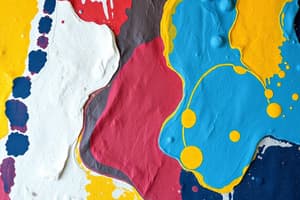Podcast
Questions and Answers
What is the significance of cave paintings in prehistoric times?
What is the significance of cave paintings in prehistoric times?
Cave paintings served as a means of expression and a visual record of daily life for prehistoric people.
What basic needs did prehistoric people need to fulfill before engaging in artistic activities?
What basic needs did prehistoric people need to fulfill before engaging in artistic activities?
They needed to fulfill basic needs such as food, water, clothing, and shelter.
During which prehistoric period did we see a significant increase in artistic activities?
During which prehistoric period did we see a significant increase in artistic activities?
A significant increase in artistic activities occurred during the Upper Palaeolithic period.
How did the lack of writing systems influence prehistoric human expression?
How did the lack of writing systems influence prehistoric human expression?
What types of objects and evidence did excavations reveal about prehistoric life?
What types of objects and evidence did excavations reveal about prehistoric life?
Why might prehistoric people have chosen cave walls as their canvas for art?
Why might prehistoric people have chosen cave walls as their canvas for art?
In what ways might prehistoric art have differed from modern art forms?
In what ways might prehistoric art have differed from modern art forms?
What can be inferred about the social structure of prehistoric communities based on their artistic endeavors?
What can be inferred about the social structure of prehistoric communities based on their artistic endeavors?
What colors are used in the earliest rock paintings mentioned in the content?
What colors are used in the earliest rock paintings mentioned in the content?
Name two sites in Karnataka and Andhra Pradesh where Neolithic paintings can be found.
Name two sites in Karnataka and Andhra Pradesh where Neolithic paintings can be found.
What subjects are commonly depicted in the rock paintings from the Vindhya ranges?
What subjects are commonly depicted in the rock paintings from the Vindhya ranges?
What are the three types of paintings documented from Karnataka and Andhra Pradesh?
What are the three types of paintings documented from Karnataka and Andhra Pradesh?
Which locations are noted for having the richest paintings, according to the text?
Which locations are noted for having the richest paintings, according to the text?
What aspect of the Bhimbetka shelter makes it significant?
What aspect of the Bhimbetka shelter makes it significant?
What type of motifs are rarely depicted in these prehistoric paintings?
What type of motifs are rarely depicted in these prehistoric paintings?
What types of scenes predominantly appear in Mesolithic paintings?
What types of scenes predominantly appear in Mesolithic paintings?
In what periods do the majority of rock paintings mentioned in the text belong?
In what periods do the majority of rock paintings mentioned in the text belong?
How were humans depicted in Mesolithic art compared to animals?
How were humans depicted in Mesolithic art compared to animals?
What materials or techniques were used by Mesolithic hunters as shown in the paintings?
What materials or techniques were used by Mesolithic hunters as shown in the paintings?
What variety of animals are depicted in Mesolithic paintings?
What variety of animals are depicted in Mesolithic paintings?
Describe the clothing or adornments depicted on Mesolithic hunters.
Describe the clothing or adornments depicted on Mesolithic hunters.
What emotional themes are suggested in the depictions of animals in Mesolithic art?
What emotional themes are suggested in the depictions of animals in Mesolithic art?
In what ways are women represented in Mesolithic paintings?
In what ways are women represented in Mesolithic paintings?
What signifies the size of Mesolithic paintings and its thematic focus?
What signifies the size of Mesolithic paintings and its thematic focus?
What significance do rock engravings and paintings hold for primitive people?
What significance do rock engravings and paintings hold for primitive people?
Describe the common themes found in Mesolithic paintings.
Describe the common themes found in Mesolithic paintings.
What does the presence of injured men in hunting scenes suggest about prehistoric life?
What does the presence of injured men in hunting scenes suggest about prehistoric life?
How do the dancing scenes from rock paintings reflect cultural practices?
How do the dancing scenes from rock paintings reflect cultural practices?
What does the realism in the depiction of individual animals in paintings reveal about primitive artists?
What does the realism in the depiction of individual animals in paintings reveal about primitive artists?
Why might artists have painted new layers over older paintings at sites like Bhimbetka?
Why might artists have painted new layers over older paintings at sites like Bhimbetka?
What insights do prehistoric paintings provide about early human beings?
What insights do prehistoric paintings provide about early human beings?
In what ways might different generations have influenced the rock painting sites?
In what ways might different generations have influenced the rock painting sites?
What is the significance of the Bhimbetka caves in archaeological studies?
What is the significance of the Bhimbetka caves in archaeological studies?
Who discovered the Bhimbetka caves and when?
Who discovered the Bhimbetka caves and when?
How many historical periods is the rock art of Bhimbetka categorized into?
How many historical periods is the rock art of Bhimbetka categorized into?
What themes are commonly depicted in the paintings of Bhimbetka?
What themes are commonly depicted in the paintings of Bhimbetka?
Describe the artistic style of the Upper Palaeolithic paintings at Bhimbetka.
Describe the artistic style of the Upper Palaeolithic paintings at Bhimbetka.
What colors are predominantly used in the Upper Palaeolithic phase's rock art?
What colors are predominantly used in the Upper Palaeolithic phase's rock art?
What types of activities are represented in the rock art of Bhimbetka?
What types of activities are represented in the rock art of Bhimbetka?
Why is it essential to study the rock paintings in Bhimbetka?
Why is it essential to study the rock paintings in Bhimbetka?
Flashcards are hidden until you start studying
Study Notes
Prehistoric Times and Art
- Prehistory refers to the time before written records existed, known as prehistoric times.
- Archaeological excavations reveal tools, pottery, bones, and cave drawings that give insights into early human life.
- Prehistoric art includes paintings and drawings found on cave walls, often expressing everyday life and cultural practices.
Periods of Prehistoric Art
- The prehistoric period is commonly divided into the Old Stone Age (Palaeolithic Age) and later phases such as the Neolithic.
- Upper Palaeolithic era witnessed a boom in artistic activities with depictions of animals and human figures.
Notable Artifacts and Locations
- Rock art sites are found globally, with significant locations in India, including Bhimbetka in Madhya Pradesh.
- Bhimbetka features around 800 rock shelters, with roughly 500 containing prehistoric paintings discovered by V.S. Wakankar in the late 1950s.
Types of Paintings
- Cave paintings contain a variety of subjects: animals like bulls, sambhars, and horses, as well as scenes of human interaction involving dancing, hunting, and music.
- Paintings are often categorized by historical periods based on style and subject matter.
Upper Palaeolithic Period
- Characterized by large animal figures and stick-like human forms, painted predominantly in greens and deep reds.
- Artworks included wash paintings and geometric patterns, showcasing the existence of hunting and social activities.
Mesolithic Period
- Features smaller paintings with numerous themes focusing on hunting, often depicting groups of people and their tools.
- Artists showcased animals in a naturalistic style, emphasizing both fear and affection towards animals, and commonly illustrated nudity and clothing in human depictions.
Cultural Significance and Layers of Art
- Multiple layers of paintings at sites like Bhimbetka illustrate ongoing cultural and ritual practices across generations.
- The repetitive re-painting might signify sacredness, dissatisfaction with earlier works, or continuity of beliefs among different generations of artists.
Understanding Early Humans
- Prehistoric rock paintings serve as a crucial means to comprehend early human lifestyles, including their daily activities, food habits, and cognitive outlook.
Studying That Suits You
Use AI to generate personalized quizzes and flashcards to suit your learning preferences.





